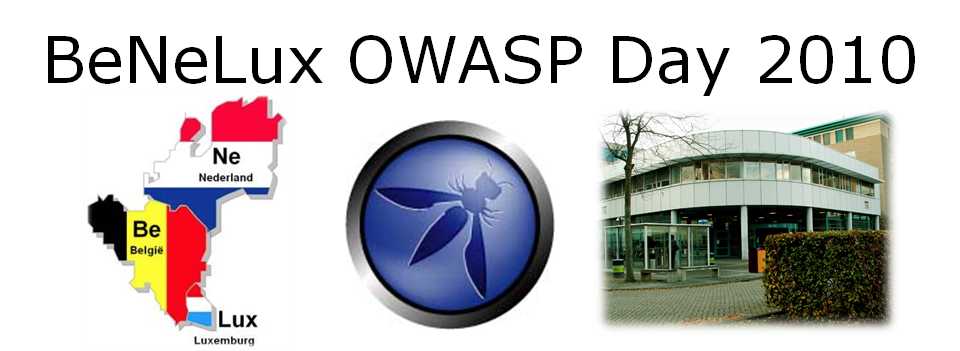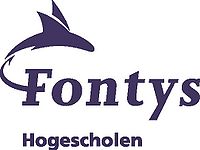This site is the archived OWASP Foundation Wiki and is no longer accepting Account Requests.
To view the new OWASP Foundation website, please visit https://owasp.org
BeNeLux OWASP Day 2010

Welcome
Presentations online
First presentations are available online. Check out the conference agenda page.
blog
Xavier did blog a nice wrap-up of the BeNeLux day: see his blog.
The Luxembourg Chapter published on Flickr a set of pictures: OWASP BeNeLux Days 2010 set.
If you know of other coverage, photo's: send them to [email protected]
Tweet!
Event tag is #owaspbnl10
Confirmed Speakers:
Sebastien Deleersnyder (OWASP Board, SAIT Zenitel)
Radu State (University of Luxembourg)
N Nikiforakis (Katholieke Universiteit Leuven)
Marco Balduzzi (Eurecom)
Walter Belgers (Madison Gurkha)
Thierry Zoller
...
Download the conference flyer here.
All the presentations will be available for download in the agenda tab.
Training, December 1st
| COURSE | |||

Part of the BeNeLux OWASP Day 2010 | |||
| Overview & Goal | |||
| |||
| Date | Venue & Directions | ||
| December 1, 2010 | Building R5 Rachelsmolen 1, 5612 AM Eindhoven, The Netherlands How to get here: | ||
| Price & Registration | |||
| |||
Conference, December 2nd
| Location - December 2nd, 2010 | ||
|---|---|---|
| 09h00-10h00 | Registration | |
| 10h00-10h15 | Welcome (by Martin Knobloch and Ferdinand Vroom, OWASP NL Chapter) | |
| 10h15-10h45 | OWASP Update (by Seba Deleersnyder, OWASP Board, SAIT Zenitel) | |
| 10h45-11h00 | Coffee Break | |
| 11h00-11h40 | Clickjacking: an empirical study with an automated testing/detection system (by Marco Balduzzi, Eurecom) Presentation
| |
| 11h40-12h20 | Privacy of file sharing service (by Nick Nikiforakis, Katholieke Universiteit Leuven) Presentation
| |
| 12h20-13h00 | Finding Backdoors in Code (by Matias Madou, Fortify) Presentation
| |
| 13h00-14h00 | Lunch | |
| 14h00-14h40 | How NOT to implement a Payback/Cashback System (by Thierry Zoller)
| |
| 14h40-15h20 | Botnets/Bredolab (by Michael Sandee, Fox-IT)
| |
| 15h20-16h00 | 0wning Networks with VoIP and Web attacks (by Radu State, University of Luxembourg) Presentation
| |
| 16h00-16h20 | Coffee Break | |
| 16h20-17h00 | The Social Networking Corporate Threat (by Chen Gour-Arie, Comsec Consulting)
| |
| 17h00-17h40 | Attacking is easy, defending is hard (by Walter Belgers, Madison Gurkha) Presentation
| |
| 17h40-17h50 | Closing (by Martin Knobloch and Ferdinand Vroom, OWASP NL Chapter) | |
Speakers
| Sebastien Deleersnyder (OWASP Board, SAIT Zenitel) |
| Sebastien started the successful Belgian OWASP Chapter and performed several public presentations on web application and web services security. Sebastien specialises in (web) application security, combining his software development and information security experience. He is currently OWASP Foundation board member and Managing Technical Consultant at SAIT Zenitel. |
| Radu State (University of Luxembourg) |
| Radu received his PhD degree from INRIA, Nancy – University Henri Poincaré in 2001. Radu has held positions as Research Engineer and Senior Engineer at INRIA-LORIA and has been working as Senior Researcher at the University of Luxembourg, FSTC-CSC Research Unit from October 2008 to September 2010. Radu's research activity will be on one side investigate interoperability aspects to supply security components in the area of ubiquitous computing and on the other side set up a project specific interoperability research lab in close cooperation with industry. |
| Nick Nikiforakis (Katholieke Universiteit Leuven) |
| Nick Nikiforakis is a PhD student at the Katholieke Universiteit Leuven, in Belgium. He belongs to the DistriNet research group and specifically in the “Security & Languages” task-force. His current research interests are: low-level security for unsafe languages and web application security. Nick holds a BSc in Computer Science and a MSc on Distributed Systems from the University of Crete in Greece. He worked for 3 years as a research assistant in the Distributed Computing Systems group at the Foundation of Research and Technology in Crete where he did research in network data visualization, authentication schemes using mobile devices and phishing countermeasures. In the past, Nick has presented his work in academic conferences as well as hacking conventions. His work can be found online at www.securitee.org. |
| Matias Madou (Fortify) |
| Matias Madou is principal security researcher at Fortify's Security Research Group, which is responsible for building security knowledge into Fortify's products. His work focuses on developing new techniques to detect vulnerabilities. Matias holds a Ph.D. in computer engineering from Ghent University, where he studied application security through program obfuscation to hide the inner workings of an application. During his Ph.D., he collaborated with top research and industry players in the field of program obfuscation. |
| Marco Balduzzi (Eurecom) |
|
Marco Balduzzi is an IT security specialist with several years of experience as engineer and consultant for different international
companies located in Milan, Munich and Nice. At the moment, he is a PhD researcher in EURECOM and a proud member of the International Secure System Lab. He designs systems for the detection of botnets/malware, the analysis of
web threats and the security of cloud computing. |
| Walter Belgers (Madison Gurkha) |
| Walter Belgers heeft Technische Informatica gestudeerd aan de Technische Universiteit Eindhoven met als extra vak o.a. Computercriminaliteit (Universiteit van Tilburg). Walter is in 1994 begonnen bij Philips C&P (tegenwoordig Atos Origin) als ontwikkelaar van wereldwijde firewall-diensten en de uitrol daarvan. Daarna heeft hij enkele jaren lesgegeven op het gebied van UNIX en Internet beveiliging bij AT Computing. In 2002 is hij toegetreden tot Madison Gurkha als partner. Naast zijn technische consultancy-activiteiten, houdt Walter zich bezig met het schrijven van artikelen en columns, het geven van lezingen en voorlichten van de pers. Walter is gecertificeerd security professional (CISSP) en security auditor (CISA). |
| Martin Knobloch (Sogeti Nederland B.V.) |
| Martin Knobloch is employed at Sogeti Netherlands as Senior Security Consultant. He is founder and thought leader of the Sogeti task force PaSS, Proactive Security Strategy, with an integral solution of information security within organisation, infrastructure and software. At OWASP, Martin is board member of the OWASP Netherlands Chapter and member of the Global Education Committee. |
| Michael Sandee (Fox-IT) |
| Michael Sandee, Lead Expert Cybercrime at Fox-IT, has been working analyzing Cybercrime for over 5 years. With day-to-day analysis of malware and cybercrime activities he has developed a good understanding on how the underground economy operates and how large this market is, and also how we are affected by this every day. |
| Chen Gour-Arie (Comsec Consulting) |
| Chen Gour-Arie has years of experience in information security, with a specific expertise in application level security. Chen
has conducted projects in all areas of information security, in diverse environments, utilizing a wide range of professional tools. Some of his notable projects have focused on: complex penetration testing, comprehensive White Box audits, network security, policy and procedure formulation, manual and automated security testing, security evaluation of products, leading secure software development lifecycles, infrastructure security audits, risk assessments, PCI and PA-DSS consulting, and more. |
CTF
During both days, a Capture The Flag challenge will be online and available!
Do you have the skills to hack websites? Can you crack various codes? Can you think outside the box? Do you like challenges?
Then come and participate in the OWASP Capture The Flag Competition. Test your webhacking/codecracking skills against various challenges. Compete against yourself and others. The CTF will run the complete conference, so you can logon and play anytime you want. We will announce the winner at the last day of the conference. The winner will earn $100 worth of OWASP books and gets a OWASP membership for a year, the runner up wins $50 of OWASP books and gets a OWASP membership for a year, the person on third place will win a OWASP membership for a year.
So come and play and earn the bragging rights for the OWASP CTF Challenge at OWASP BeNeLux 2010.
Registration
The training day and the conference are free!
To support the OWASP organisation, consider to become a member, it's only US$50!
Check out the Membership page to find out more.
Venue
Hogeschool Fontys
Building R5 , Rachelsmolen 1
5612 AM Eindhoven, The Netherlands
Hotels nearby: maps.google.nl/maps
Organisation
The BeNeLux Day 2010 Program Committee:
- Martin Knobloch / Ferdinand Vroom (OWASP Netherlands)
- Bart De Win / Sebastien Deleersnyder (OWASP Belgium)
- Jocelyn Aubert / Andre Adelsbach (OWASP Luxembourg)
Sponsorship
Contact netherlands <at> owasp.org for sponsorship
<paypal>BeNeLux OWASP Day 2010</paypal>
Social Event
The social event is scheduled for Wednesday, 1st of December: Effenaar, starting from 7 pm!









